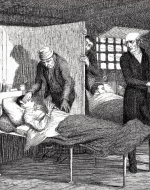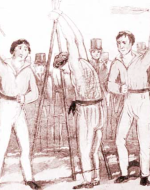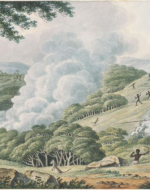As we know, Australia was initially a penal colony created by Britain. In 1597, the initial law of banishment was introduced to England and convicts began to be shipped around the New World. However, beginning in 1770, convicts were shipped to Botany Bay, the first penal colony in Australia. Originally discovered in 1770 and charted for Britain by James Coo who called the land New Wales. Cook's first interaction with the indigenous inhabitants of Australia, the Gwaegal, was not peaceful, firing by gun and spear was present at Cook's and the two men's first meeting. Dr. Shayne T. Williams, Ph.D explains the context behind this first documented interaction. As a descendant of the Australian indigenous group the Dharawal, he explains that "In our cultures it is not permissible to enter another culture’s Country without due consent. Consent was always negotiated." and explains that both the protection of territory as well as the negotiation were spiritual in nature to the Gwaegal, and that the actions shown towards Cook was within spiritual duty.
However, mass fatalities occurred due to the colonization of Australia. Not only from the indigenous inhabitants, dying from disease and violence brought by Britain, but also within the populations of convict being transferred to Botany Bay and other colonies. Over 160,000 convicts were sent to Botany Bay between 1788 and 1850 roughly being about 3,000 people per year. The majority of these ships were retired slave ships, with horrible conditions and raging disease. Thomas Milburn, a convict being transported during the late 1700's wrote "[We were] chained two and two together and confined in the hold during the whole course of our long voyage…[W]e were scarcely allowed a sufficient quantity of victuals to keep us alive, and scarcely any water…[W]hen any of our comrades that were chained to us died, we kept it a secret as long as we could for the smell of the dead body, in order to get their allowance of provision.... I was chained to Humphrey Davies who died when we were about halfway, and I lay beside his corpse about a week and got his allowance (Hughes 145-146). This is a scarring and deeply disturbing account of these criminal's reality while being transported to Australia. The neglect of food and hygiene caused these men to make unthinkable decisions to survive, such as we see in Milburn's example.
Conditions improved after 1811 as William Redfern, being a doctor as well as a convict, encouraged cleanliness, exercise, and proper ventilation dropped fatalities from 1 in 31 to 1 in 122. However, transport still continued up until it was abolished in 1868. This seems like ages ago, when in reality, this was a mere 150 years ago. The horrors of colonization brought not only to the indigenous populations of Australia as well as the criminals sent there during the Victorian era will always remain as a dark age in history.
Sources :-Hughes, R. (1988).The Fatal Shore: The epic of Australia’s founding. New York: Vintage Books.
Williams, S. T. (n.d.). An indigenous Australian perspective on Cook's arrival. British Library. Retrieved December 2, 2021, from https://www.bl.uk/the-voyages-of-captain-james-cook/articles/an-indigen….
Alvater, L., Lenhoff, A., & Peters, E. (n.d.). The Victorians and Australian penal colonies. British Literature Wiki. Retrieved December 2, 2021, from https://sites.udel.edu/britlitwiki/the-victorians-and-australian-penal-….




